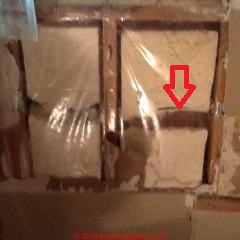 UFFI - Urea Formaldehyde Insulation Shrinkage Gaps
UFFI - Urea Formaldehyde Insulation Shrinkage Gaps
& Dust Control When Removing UFFI Insulation
- POST a QUESTION or COMMENT about how to recognize UFFI Urea Formaldehyde Insulation in buildings and its effects on the property
UFFI insulation shrinkage & heat loss defects:
UFFI shrinkage may reduce its effectiveness in buildings. Examining a 1970's UFFI insulation retrofit job in a New York home we observed significant shrinkage gaps at the sides and top of UFFI insulation in the building's walls.
These gaps, especially in an older home, permit air leas and un-wanted heat loss, sacrificing some of the expected benefit of this spray foam insulation method.
Page to photo: very large shrinkage gaps in blown-in UFFI insulation in this home were revealed by InspectApedia.com reader Thomas Salisbury who decided to remove all of the UFFI from the home.
This article series on UFFI insulation illustrates and describes UFFI - urea formaldehyde foam building insulation and describes where it is found, when it was used in buildings, how to look for it, how to distinguish this from other building foam insulation products, and its health effects. We include identification photographs and a description of a very simple field test that can immediately distinguish between 1970's vintage sprayed or pumped UFFI insulation and more contemporary icynene or polyurethane spray foam insulation jobs.
InspectAPedia tolerates no conflicts of interest. We have no relationship with advertisers, products, or services discussed at this website.
Urea Formaldehyde Foam Insulation UFFI Shrinkage and Thermal Bypass Leaks
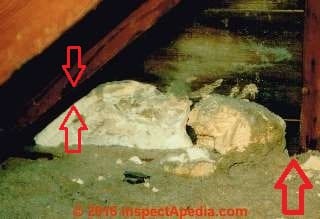 Look for UFFI foam spray insulation shrinkage: Neither latex foam spray insulation nor icynene foam spray insulation have the shrinkage problem of UFFI.
Look for UFFI foam spray insulation shrinkage: Neither latex foam spray insulation nor icynene foam spray insulation have the shrinkage problem of UFFI.
If you have occasion to open a building wall cavity where UFFI was installed, you'll typically see about an inch of shrinkage at each side of the foam insulation block, and you'll see a couple of inches or more of un insulated space at the top of the column of sprayed foam.
Our photo illustrates side gap shrinkage in two locations where UFFI was pumped into the walls of this Poughkeepsie New York home on the Vassar College campus. In the foreground is loose-fill cellulose insulation blowin into this attic floor.
The light tan colored foam in the center of the photo is the top of UFFI that was blown into the wall cavity, most-likely durig the 1970's. You can ignore the cracked gap in the center of the foam as we can't say that that defect would be common.
But notice the significant air gap along the right side of the foam block in the wall cavity. There is about an inch of shrinkage gap between the side of the insulating foam block and the side of the wall stud.
A similar shrinkage gap is visible between the top-left side of the foam block and the sloping 2x outlook rafter at the gable end wall of this attic space.
The amount of UFFI insulation shrinkage varied from home to home and was probably the result of how precisely the product was mixed during installation, so the amount of shrinkage may vary among buildings.
An expert use of thermography or even infra-red scanning of a building exterior wall in cold weather, with the heat on indoors, may be able to detect this insulation shrinkage too.
See FORMALDEHYDE HAZARDS where we describe the sources of this contaminant, exposure levels, and steps to reduce formaldehyde levels indoors.
Removing Cracked, Shrunken UFFI Insulation from an Older Home - UFFI Dust Particle Hazards?
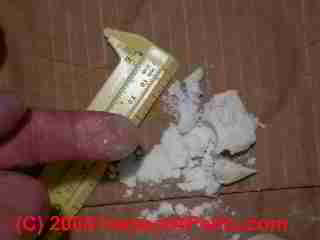 Shown here: protective gear during UFFI removal and photographs of shrinkage gaps and large crack gaps in UFFI insulation revealed in the walls of an older home.
Shown here: protective gear during UFFI removal and photographs of shrinkage gaps and large crack gaps in UFFI insulation revealed in the walls of an older home.
Question: what is the particle size of UFFI dust
(June 13, 2018) Thomas A Salisbury said:
I am looking to remove the UFFI from the cavity walls of my house. Does someone know the particle size of UFFI dust? I plan to purchase a HEPA filtered vacuum to collect and bag the material.
I have seen vacuums claiming to collect everything above 0.3 microns in size. Thanks.
This question and answer were posted originally at UREA FORMALDEHYDE FOAM INSULATION, UFFI - home
[Click to enlarge any image]
Reply: UFFI dust particles can be as small as 1u
Thomas
UFFI dust particles range from rather large (100u and up, larger than the thickness of a human hair) to very small, in the sub-micron range, but certainly many will be in the 1u (1 micron) range as we'll elaborate below.
As a point of reference, typical human hair is around 25u and ranges from 17 to 180u in thickness. How small is 1u for people who are familiar with the inch-scale? 1u = about 0.00004 inches.
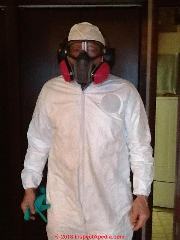 About using a HEPA-rated vacuum cleaner, you want to remove very small particles.
About using a HEPA-rated vacuum cleaner, you want to remove very small particles.
Watch out: That's because breathing any very small particles can send them deep into the lungs where they can be more-difficult to expel and where they might present a health hazard.
See details at UFFI REMOVAL PARTICLE SIZE HAZARDS
A vacuum that will safely collect particles that are 0.3u and larger will do a credible job though no vacuum cleaner is likely to remove all of the very smallest sub-micron sized particles of any material.
Watch out: our friend Jeff May tested HEPA-rated vacuum cleaners years ago and found that many of them leaked so badly that even though the vacuum cleaner filter was HEPA-rated the vacuum cleaner actually increased the level of airborne particulates in the work area.
Jeff's work, though entirely credible, is old, now, so you'll want to simply look for a vacuum cleaner that appears to leak as little as possible.
Watch out: also, because UFFI is so fragile its particles can easily include down in the 1u range or even smalle. (Pross 1987)
Photo: the reader's photo illustrates tyvek coveralls, full face respirator and gloves worn during removal of UFFI from a building. The health concern here was the possible respiration of ultra-small sub-micron airborne UFFI dust particles.
There would be no significant formaldehyde offgassing from an old UFFI insulation job.
Why Remove UFFI from a Building?
Why are you removing the insulation? UFFI is not harmful in place.
Perhaps because it's not effective? The central issues with an older home with UFFI insulation are
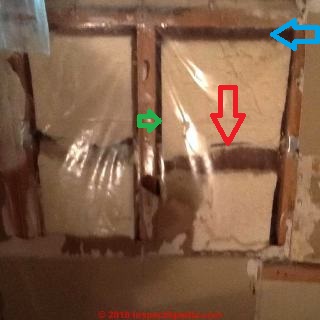 1. Gaps in UFFI insulation may have formed at top and sides of insulation pumped into wall stud bays if the mix was improper and the insulation shrank, leading to points of heat loss.
1. Gaps in UFFI insulation may have formed at top and sides of insulation pumped into wall stud bays if the mix was improper and the insulation shrank, leading to points of heat loss.
See UFFI INSULATION GAP LEAKAGE found below in this article.
2. Consumer fear of UFFI: a residual consumer fear of UFFI, though generally not justified, can impact property re-sale time or price.
See UFFI ENVIRO-SCARE - Urea Formaldehyde Foam Insulation then use your browser's "back" button to return here.
Reader follow-up: we are removing all insulation: we want to fir out the walls from 2x4 to 2x6
(June 13, 2018) Thomas A Salisbury said:
Thanks for the reply. We want to fir out the walls from 2x4 to 2x6 to beef up the R-value. Yes, the UFFI has shrunk, causing very hot days in summer.
We could leave in place but would rather just eliminate the UFFI.
My wife is acutely sensitive to various airborne dust. We are remodeling the house adding new windows, doors, etc., so we will be exposing the UFFI to the air, so I want to just remove it as we do the project.
When you say 1u, how does what is the equivalent in microns? Thanks.
Photo: large UFFI shrinkage gaps (red arrow) were found where electrical wiring passed through the material. It appears that the wiring held the upper portion of the foam in place and allowed the lower portion to fall several inches leaving a significant gap in the wall insulating blanket.
The tip of our red arrow just touches the electrical wire running through this wall cavity.
Blue and green arrows point to additional top and side shrinkage gaps around this UFFI insulation.
Reply: UFFI particles range from large (over 100u) down to 1 u = 1 micron or smaller
1 u = 1 micron in my lingo. sorry for the confusion.
I'd handle the job as if it were asbestos - controlling dust, negative air, thorough cleanup, so as to avoid leaving irritating dust particles for Mrs. Wife.
Also see AIRBORNE PARTICLE SIZE DEFINITIONS & TYPES
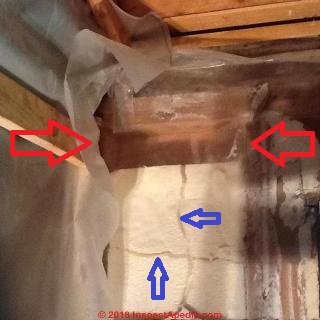 Reader follow-up: protection & dust management during UFFI removal
Reader follow-up: protection & dust management during UFFI removal
Thanks for the conversion info.... and yea, I'll be extremely careful with the remediation when it starts.
I inadvertently punctured an exterior wall sheetrock today as I demolished the hall bathroom, and I saw UFFI dust float out into the air.
Will be getting a Nikro HEPA vacuum (which claims a 99.97% dust collection at 0.3 microns) next week, so I will begin the removal then. Thanks again for the replies.
As reader Thomas A. Salisbury commented about the UFFI photo shown here:
You can see the crazy gap at the top of the stud cavity [red arrows]. When the temperature is 85 outside, the house can get up to 90. I now know why!
Our smaller blue arrows mark additional gaps and cracks in this block of UFFI in the wall stud bay cavity.
Reply:
Glad to assist however we can.
I would much appreciate seeing some photos of your situation including what the wall cavities and the UFFI look like when you open the wall.
Often that information will allow us to make other suggestions or comments.
Reader follow-up:
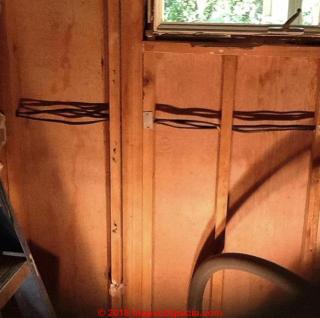 Here are some images [photos appearing throughout this discussion] of the first round of vacuuming. I started with a bathroom exterior wall.
Here are some images [photos appearing throughout this discussion] of the first round of vacuuming. I started with a bathroom exterior wall.
The images include the safety gear worn, the UFFI above the window header, the UFFI shown at the top of a stud cavity, the UFFI separated around the electrical wire runs through the wall, and a shot of the walls after vacuuming.
Overall, it went quite well and the Nikro did a heck of a job sucking up the bricks/dust.
Some dust escaped into the air, so the safety clothing and gear is definitely needed.
The vapor barrier helped to keep the UFFI contained as I moved from top to bottom.
A bristle brush attachment after removing much of the UFFI helped to remove the UFFI still clinging to the exterior wall and stud.
I used an air monitor instrument to check on the air contamination.
The dust contamination scale never rose beyond moderate, but mostly stayed in the good range.
The formaldehyde quality never moved from good as did the Air Quality scale.
I wore a 3M mask that protected against formaldehyde and had a P100 dust protection.
Looks like I can only send one image at a time, so I will send successive images.
Reply:
It's no surprise that your monitoring for airborne formaldehyde did not change during the removal of old UFFI insulation in your home.
UFFI is an open-celled foam. For UFFI insulation that was probably installed in the 1970's there is pretty-much no chance that it would still be off-gassing formaldehyde in 2018.
Instead, if formaldehyde is detected in a building currently it's almost certainly from another product or source .
At FORMALDEHYDE HAZARDS we discuss where formaldehyde is likely to come-from in recent or current construction.
Glad to assist however we can.
Research on UFFI Dust Management & Particle Size
- Frigos, Evangelo, Warren V. Filley, and Charles E. Reed. "Asthma induced by dust from urea-formaldehyde foam insulating material." Chest 79, no. 6 (1981): 706-707.
Abstract/Excerpt:
A patient developed severe asthma following insulation of her house with urea-formaldehyde foam. Bronchial challenge with the buoyant dust of the foam caused an asthmatic attack; inhalation of formaldehyde, 3 ppm, did not.
Really? See Newhouse (1982) given below. - Gammage, Richard B. "Exposure to formaldehyde in indoor air." Risk Analysis 10, no. 1 (1990): 77-83.
- Newhouse, Michael T. "UFFI dust: nonspecific irritant only?." Chest 82, no. 4 (1982): 511.
Excerpt:
Because of the controversy about the possible health hazard of urea formaldehyde foam insulation (UFFI), I think it important to reassess the strength of the evidence suggesting that disease might be related to this material.
The paper by Frigas, Filley and Reed, “Asthma induced by dust from urea-formaldehyde foam insulating material,” (Chest 1981; 79:706-07) is a case in point.
This paper has several serious deficiencies which in my opinion make it questionable whether one can draw the conclusions stated by the authors, for the following reasons:
1.The study could certainly have been carried out single-blind and this should have been done, particularly in a situation such as this where on the patient’s part it is likely that deterioration of asthma will be attributed to the UFFI because possible hazards from this insulating material have been much publicized in newspapers and on television.
A double-blind study would have been preferable and certainly far from impossible.
2.The authors should have measured nonspecific reactivity and exposed asthmatic not living in UFFI homes but shown to have a similar level of nonspecific reactivity, to the foam dust to be sure that the response was not a nonspecific one resulting from dust.
3.The use of aluminum oxide dust as a nonspecific dust stimulus may be invalidated by the fact that this material has a density approximately four times that of water and many times that of UFFI.
This would result in inhalation into the lower respiratory tract of very much less of the aluminum oxide dust depending on the particle size to which the dust was milled. It is unlikely that the two exposures were comparable.
4. At the time of these studies, this patient was doubtless very hyperreactive, because she required systemic steroids in addition to her usual bronchodilators.
It is well known that such hyperreactivity may vary (for example a viral infection within weeks or months might increase hyperreactivity which may subsequently gradually decrease) so that the fact that she got better after she left her home and required somewhat less therapy, while at the same time the life-threatening episodes ceased, may merely have been a coincidence.
As a minimum, she should have been challenged with the UFFI dust again after being out of her home for several weeks or months to confirm that she was indeed sensitive to the
material rather than responding in a nonspecific way. 5.The fact that it took three successive challenges over a 30-minute period to evoke any response, followed by an unusual pattern of response—slowly progressive over one hour, is unusual and should certainly have been confirmed with a second test.
6.For the study to have been convincing, an occupational work exposure type test should have been performed in a double-blind fashion using as a control a similar dust not containing UFFI and in a research setting where the nonspecific airway hyperreactivity had been well established previously.
Only by demonstrating that the UFFI specifically caused bronchoconstriction in this patient while another asthmatic with a very similar level of nonspecific hyperreactivity did not respond, could be considered convincing evidence that UFFI indeed caused her asthma.
As it stands, this paper is not convincing and does not constitute evidence that UFFI dust is asthmagenic except in a nonspecific way. - Lees, R. E. M.,M.D., R. H. Clark, Ph.D., & J.H. Day, "Respiratory Responses to Formaldehyde,
Formaldehyde Free UFFI Off-gas And Particles in UFFI-Related Asthma", Queens University, Kingston, 1985 Mosby
Abstract:
The study concerned itself with the respiratory effects of low quality (high gas-dust) emitting UFFI which exists in certain buildings and its possible effects upon airways of asrhmatics who relate symptoms to UFFI in their living env;ronment.
21 of 24 subjects completed tests in a chamber1 as did 4 asthmatic controis. The following 3 hour exposures were undertaken: placebo, formaldehyde gas 0.54 ppm, UFFI particles 0.5/ml and formaldehyde Free UFFI off-gas from selected low-quality UFBT, Greater than 10% drop FEVl was considered to be positive in tests performed immediately and 24 hours post exposure. There was no consistent group response to the various challenges.
One test subject and two controls responded to formaldehyde, 7 test subjects and 2 controls to UFFl. dust, 3 test subjects and 1 control to formaldehyde free UFFI off-gas. All reactors but one were methacholine responders. Normally observed concent rat i.ons of formaldehyde, and UFFI dust, and a-7 well as formaldehyde free UFFI off-gas from low quality TJFFI delivered for three hour periods in a chamber produced no consistent bronchial effects on asthmatic subjects.
9/10 subjects reacting to one or more UFFI components were methacholine responders. The quality of U’FFI may be a factor in the development and persistence of asthma in some persons. - Pross, H. F., J. H. Day, R. H. Clark, and R. E. M. Lees. "Immunologic studies of subjects with asthma exposed to formaldehyde and urea-formaldehyde foam insulation (UFFI) off products." Journal of Allergy and Clinical Immunology 79, no. 5 (1987): 797-810.
Excerpt: The UFFI dust was clearly visible on the floor of house “a” and in the vacuum dust. Microscopic examination revealed UFFI particles ranging in size from 100pn down to submicron. - Spengler, John D., and Ken Sexton. "Indoor air pollution: a public health perspective." Science 221, no. 4605 (1983): 9-17
[includes discussion of respirable UFFI particles] - U.S. EPA, "Particulate Matter (PM) Pollution, Particulate Matter (PM) Basics, What is PM, and how does it get into the air?" [PDF], retrieved 2018.07/06, original source: https://www.epa.gov/pm-pollution/particulate-matter-pm-basics
Calculating the Loss in Building Insulation Effectiveness Due to UFFI Insulation Shrinkage
Thanks to recent correspondence from a reader, we provide this "back of the envelope" calculation of the percentage of wall area insulation lost due to UFFI insulation shrinkage.
Be sure to measure your own building carefully by opening one or more wall cavities for actual examination, as the amount of UFFI shrinkage may vary significantly from one building to another.
First of all, the UFFI foam insulation shrinkage stops after the foam has fully cured. Typically within the first year or less of installation. So the problem does not continue to worsen over time.
We could calculate, even before an IR scan of the building, the total area of un insulated space in the exterior walls by examining one or two sample wall cavities to measure the actual UFFI shrinkage.
Typically, where UFFI shrinkage has occurred, we observe 2-4 inches of uninsulated space at the wall cavity top between each pair of wall studs, and about one inch of shrinkage and uninsulated space at each side of the original foam block in the stud bay. This is what we found for a Poughkeepsie NY home investigated in detail during siding renovations.
A back of the envelope calculation suggests that this means we've got roughly (3x16)+(2x96) = (48)+(192) = 240 square inches of uninsulated surface in every 16" wide x 8 foot high wall stud bay cavity (1536 sq.in), or about 240/1536 = 15% of the wall cavity space is not insulated.
If you know the total square feet of wall area (subtract out windows and doors) and if you confirm that your walls were framed with studs 16" on center, you can repeat our calculation with your own UFFI shrinkage measurements. (Contact Us to send photos of what you find).
Using actual measurements from your sample cavity you could calculate the total uninsulated area for the home, and ultimately the probable heating cost savings - but beware, as we comment below, if there are other building air leaks, including thermal convection in interior partitions, the air leaks and convection losses will overwhelm even a well insulated building. More on this later.
You could add blown-in insulation around the UFFI, but it would be labor intensive as drilling to insert the new foam would need to be thoughtfully done.
We *speculate* that it would be possible to inject a new foam product, perhaps icynene, for example, at the top of the cavity - that's where the widest shrinkage will occur as it's over the whole height of the material, leaving smaller gaps at the sides - and that at least some of the new foam would run down the sides of the old material as well.
But because the old UFFI is quite fragile, very easily compressed to a powder, blowing in new foam might also, depending on its pressure, actually crush the old material, causing it to collapse, leaving a larger uninsulated hole than before you started.
Therefore what we recommend is that an owner of a UFFI insulated building should try to convince a foam insulator (probably more effective at spreading down gaps than cellulose blow in) to help me do an experiment. It's an experiment because we are not going to insulate the entire home (and pay that high cost) before we know exactly what is going to happen when foam is injected into the UFFI-insulated wall cavities.
- Select two or three typical wall cavities that are easily accessible, blow in the foam from whichever building side is easiest - outside or inside.
- Let the new foam dry and cure completely.
- Cut open the entire wall cavity on one side, probably the inside as drywall or plaster are easier to replace, and see what happened - checking for old foam collapse and the extent of remaining voids.
- Take photographs of both a treated and an un-treated cavity - and please send us copies so that we can comment further, and also so that we can help others who face this question.
IF we find that the addition of another insulation causes more harm than good, or does not appear cost justified, I would focus my strategy on sealing air leaks - that will give by far the most bang for the buck - see these articles for more detailed help with air leaks and building insulation retrofits. See AIR BYPASS LEAKS
Research on UFFI Shrinkage in Buildings
- Bissett, John. "Fungi associated with urea-formaldehyde foam insulation in Canada." Mycopathologia 99, no. 1 (1987): 47-56.
Abstract:
Sixty-eight fungal taxa were identified from samples of urea-formaldehyde foam insulation taken from Canadian residences. Mesophilic taxa were predominant, with Penicillium spp., Trichoderma harzianum and Paecilomyces variotii observed most frequently. Extensive or conspicuous growth also was seen for Hormoconis resinae, Stachybotrys chartarum and Trichoderma viride in some samples. The potential for these fungi to have contributed to the adverse health effects reported in some homes containing UF-foam insulation is discussed.
Excerpt 1: High temperatures and humidity accelerate deterioration of UFFI, leading to breakage of the foam cell walls and shrinkage of the foam [6].
Excerpt 2: Although off-gassing was initially thought the probable cause of the reported adverse health effects in some UFFI homes, studies to date do not show a clear correlation between adverse symptoms and the concentratio nof off-gases from foam insulation. Consequently, other facctors associated with UFFI, including the presence of fungi, have been investigated as concomitant causes of tehse adverse health symptoms. - Brown, Stephen K. "Field Performance, Hydrolysis and Durability of Urea Formaldehyde Foam Insulation in Australian Dwellings." In Insulation Materials: Testing and Applications, 2nd Volume. ASTM International, 1991.
- Brown, S. K. "Hydrolysis and durability of urea formaldehyde foam insulation." Polymer degradation and stability 27, no. 2 (1990): 121-143.
Excerpt: It was recommended that the hydrolytic stability of UFFI be assessed according to shrinkage which should not exceed 15% by volume (5.3% linear) after exposure to 60C and 75% RH for 30 days. - Cohen, S. David. "The Public and Private Law Dimensions of the UFFI Problem: Part I." Canadian Business Law Journal 8 (1983): 309.
- Crawford, Carl B., and C. J. Shirtliffe. "Urea-Formaldehyde Foam Insulation." (1984): 108-111.
Excerpt: Literature describing experiences in several other countries was reviewed and many walls containing UFFI were opened. An early conclusion was that the thermal resistance of trie foam is greatly reduced by shrinkage.
Reader Comments, Questions & Answers About The Article Above
Below you will find questions and answers previously posted on this page at its page bottom reader comment box.
Reader Q&A - also see RECOMMENDED ARTICLES & FAQs
On 2021-06-21 by inspectapedia.com.moderator (mod) - strategy for filling in UFFI Shrinkage Gaps with Spray Foam Insulation
@Michelle,
Chemical compatibility between UFFI and modern spray foam insulations is not a concern nor is the UFFI itself: it's not toxic, though I agree that demolishing UFFI can, if not done with care, produce a lot of fine particulates that may still be a respiratory hazard, and a mess. It's particle size, not particle chemistry that is the hazard in this case.
Filling the shrinkage gaps around UFFI in a building without tearing open walls is entirely possible but tedious and costly, though less-costly than removing wall coverings inside or out: one simply pumps any modern foam insulating product, probably an open-celled foam, into those cavities;
The rub is that in a completely-vacant wall stud by it's pretty easy to reliably fill the stud bay with foam by pumping through one or two holes cut in interior or exterior walls - depending on the situation - 16" o.c. for conventional framing. But in the UFFI shrinkage-gap case, I'm not confident that foam pumped at the very top of the wall stud bay will fill the side gaps down to the wall bottom so at least two more holes, maybe four, will be needed: increasing the labor cost to do the job.
I suspect that that's the reason that many homeowners, even after understanding that the UFFI is itself harmless left in place, end up opening walls and re-insulating them as part of a building renovation project.
For a home with exterior cladding in good condition, it's usually less costly to do that from the inside - drywall R&R is less expensive per square foot than exterior siding R&R.
SUGGESTION:
If you can find a foam insulation company who's willing to cooperate in an experiment, I would try pushing foam into one or two stud bays, starting with making an opening first just a the stud bay top (where the shrinkage gap is widest);
Giving that foam time to set I'd actually open the wall to see how far we pushed the foam; if it won't reach wall bottom (I think it won't) then you and the insulator can determine how many openings are needed, and where, to reliably re-insulate a UFFI-Gapped building wall cavity.
That game plan will give more-reliable results.
I would not simply pay an installer to foam willy-nilly or without some basis for confidence that we're accomplishing what we set out to do: fill the UFFI shrinkage gaps.
Otherwise we're paying for an expensive foam insulation job without any assurance of its success.
A 1-inch gap extending along the existing UFFI insulation sides in every wall stud bay is a tremendous heat loss source for a building for two reasons:
The missing insulation
The failure to stop the air leakiness that is de-rigeur in the character of older homes.
see also
FOAM SPRAY INSULATION TYPES
On 2021-06-21 by Michelle - is it possible to spray another insulation in gaps around UFFI and is it safe?
This is my question...how to seal the cracks caused by shrinksge in the insulate. Is there any data on using another spray insulate (chemicsls all of them) in addition to old UFFI? Thank you!
Thank you for the extensive info on UFFI.
Buying a beautiful older home with it in walls. How would I go about fixing thermal bypass leaks from shrinkage witjout removing it?
R value of the home is low and I have no interest in removal of walls and insulate that could cause dangerous oarticulate matter to be airborne.
Is it possibke to spray another insulate in gaos around the UFFI and is it safe? I'm concerned about the mixing of chemicals. Since you can't use UFFI to fill it up, this would involve mixing very different chemicals. Has anyone got ideas or experience on how to improve R factor without stripping the house down and redoing all insulate? Thank you for your feedback.
On 2021-04-18 by (mod) - how to clean up UFFI dust particles
@RCL-UFFI, I'm glad to discuss this with you and and happy if I can be helpful but I want to be careful to emphasize that I'm not a UFFI expert.
I guess if I had to make a compromise and clean up any very fine dust, perhaps short of asbestos, without using a HEPA vacuum cleaner I would probably wear proper HEPA respirator and would take care to have some fans blowing out of the work area to Outdoors to try to minimize the dust that escaped my homemade do-it-yourself drywall dust vacuum cleaner.
If you wait a day after your vacuum the experiment and don't see any notable settles dust on surfaces in or near the work area you probably don't have much more cleaning to do
but if you do see some new settled dust you probably want to do some damp wiping and maybe another vacuum pass.
About those voids around the UFFU insulation, it's a reasonable plan to try to blow some foam into those areas. Expanding foam may crush a little bit of the UFFI in his path but I don't think that hurts a thing.
On 2021-04-17 by RCL-UFFI
Hello Dan. Thanks all so much for your in-depth and "mind altering" comments of 2021-04-13. Over several years I had convinced myself that I'd (one day) press forward and remove the UFFI by one means or another. Your comments hit me like a ton of bricks and convinced me to back off and look for alternatives.
That will save me weeks and months of remediation work. I took a peak behind the walls and believe that
(1) the UFFI foam has subsided about 5" from the top side and
(2) I sense that there isn't much UFFI foam near the bottom after peering through my utility holes.
However, I did want to ask one indirect question
. I'd still like to vacuum up some loose UFFI foam which is here and there. Of course it turns into powder when touched. I don't want to go out and rent a HEPA vacuum but I do have a generic ShopVac. I was thinking of putting it outside the home with an extended series of make-shift pipes and use a generic "drywall dust" bag for it
. I know that is not ideal. I guess I'll find out if it works or not. But I did want to ask in advance whether this would be sufficient to deal with a small amount of UFFI powder dust cleanup or whether the powder would blow right through the vacuum. Thank you again for your comments as they were a game changer for me.
On 2021-04-13 by (mod) - Urea formaldehyde foam insulation removal guidelines
@RCL-UFFI,
I'm sorry you had trouble finding this page again - should our obscurity form a stumbling block some other time, just shoot an email to the editor or post a request on any page - as we try to respond to reader comments promptly.
You'll see at the Recommended Reading and Recommended Articles above our whole collection of articles assessing UFFI insulation.
Your question about how to remove UFFI insulation might be starting from a false premise: that the insulation should be removed. Generally it need not be removed.
An exception that I discuss on this page is UFFI removal in blocks or chunks as part of building renovation when walls are opened to reveal sizable gaps or insulation faults where the original UFFI shrank after installation.
I've had clients who removed UFFI as well as some readers who commented on the process.
In my opinion there is no environmental or other reason to remove the insulation as it's pretty harmless; an off-gasssing concern, if there was one (there was not in all cases) ought to have been way over-with decades ago. Independent tests such as those conducted in Connecticut in the 1980s found such low levels of formaldehyde that a UFFI-formaldehyde hazard was pretty much put to bed. (There can, of course, be other sources of formaldehyde off-gassing in buildings such as from some particleboard products and some wood-flooring products. )
Also in my opinion, trying to remove and simultaneously collect old UFFI insulation from building walls and ceilings using a Shop Vac to suck insulation into vacuum cleaner bags is not only unnecessary but is likely to be a slow and tortous procedure.
On buildings I inspected where there was UFFI, discussed with clients the defect that in some installations, largely depending on how the foam was mixed, shrinkage can leave gaps in wall stud bays along the sides and at the top of each bay.
At a Poughkeepsie home where we opened the walls for other renovations I saw about an inch of air space on each side of the UFFI blocks and a couple of inches at the top of the block.
Some people use that situation as an opportunity to try to remove the UFFI and re-insulate with a modern non-shrinking open or closed cell foam (those are discussed at InspectApedia.com as well).
You will probably find that it's a mess taking the old UFFI out if you don't handle it carefully; it is fragile and easily breaks into small bits and lots of messy powder. I'd take great care for dust control, wear a respirator, etc to reduce the mess. It's not so much that the particles are toxic but they're small and not something you want to breathe for that reason.
Blowing outside is part of dust control but still you don't want to blow an inch of UFFI snowfall over your yard or neighbours.
If you have to remove and compress the material I'd try to get chunks intact into a big heavy duty contractor bag, close it to do any smashing, then open it carefully to add more material.
Yes I like cleanup with a HEPA vac.
Urea-Formaldehyde Foam Insulations: A Review of Their Properties and Performance [PDF] at https://inspectapedia.com/insulation/UFFI-Technical-Notes-NIST.pdf
is worth a look
Here are some helpful publications and guidelines that include discussion of UFFI, leaving it alone or removing it:
- Carson, Alan, & Jogn Caverly, UREA FORMALDEHUDE FOAM INSULATION [PDF] original source: https://www.carsondunlop.com/inspection/blog/urea-formaldehyde-foam-insulation/
Excerpt:
The purpose of this paper is to provide home owners and home buyers with the facts, and some guidance, concerning the use and safety of urea formaldehyde foam insulation (UFFI).
Mr. Caverly can be found at Building Inspection Consultants and Associates,
Mr. Carson at Carson, Dunlop & Associates Ltd., 120 Carlton Street Suite 407, Toronto ON M5A 4K2. (416) 964-9415 1-800-268-7070 info@carsondunlop.com. The firm provides professional HOME INSPECTION SERVICES, HOME INSPECTION TRAINING, Horizon INSPECTION SOFTWARE & PUBLICATIONS. Alan Carson is a past president of ASHI, the American Society of Home Inspectors. Thanks to Alan Carson and Bob Dunlop, for permission for InspectAPedia to use text excerpts from The Home Reference Book & illustrations from The Illustrated Home. - CT DOH, UREA FORMALDEHYDE FOAM INSULATION (UFFI) FACT SHEET [PDF] (2015) Connecticut Department of Health, retrieved 2021/04/13 original source: https://portal.ct.gov/-/media/Departments-and-Agencies /DPH/dph/environmental_health /eoha/IAQ/081415UFFIFSpdf.pdf
Excerpt: health officials do not believe that UFFI installed in homes during the 1970-80s represents an exposure problem today. - NRC, Canada, Development Of A Canadian Standard For Urea Formaldehyde Thermal Wall Insulation The National Research Council of Canada (1981)
- Rossiter, Walter J. & Robert G. Mathey, UREA-FORMALDEHYDE FOAM INSULATIONS: A REFFIEW OF THEIR PROPERTIES and PERFORMANCE [PDF] U.S. NIST, retrieved 2021/04/13 original source: https://nvlpubs.nist.gov/nistpubs/Legacy/TN/nbstechnicalnote1210.pdf
- U.S. CPSC, An Update On Formaldehyde
U.S. Consumer Product Safety Commission, Washington, D.C. (1990)
On 2021-04-13 by RCL-UFFI
I had come across this WEB page several years ago and it solely had given me the incentive to remove the UFFI from my basement walls. I have finally come about to start that job now. However, it took months to find this page again and fortunately I bumped into it a few hours ago. I'd love to connect up with the persons whom have done UFFI remediation with a HEPA vacuum.
I do have some "new user" concerns and questions. Let me paraphrase... I've located a HEPA vacuum available at United Rental with 10L of capacity and a rectangular HEPA filter.
I was thinking of keeping the unit outside and jury rigging a series of 2" pipes into the house.
I also have a Craftsman 40L ShopVac that I could use. My main and worrisome concern revolves around how to deal with bagging of the UFFI. 12-16 gallon ShopVac bags cost upwards of $30 for only 4 - I can't imagine how many I would need to remove the UFFI from 50 linear feet of basement wall.
So, to those that have done this themselves, how do you deal with bagging the UFFI from a HEPA vac or a ShopVac and how many have you used for the entire project?
I know that UFFI compresses quite well but I have yet to learn how much I can squeeze into each 12-16 gallon ShopVac bag. Also, how important is it to get a Tyvek suit if I have the vacuum outside and I install a high powered fan to create negative suction in the room?
...
Continue reading at UFFI INSULATION IMPACT ON HOME SALE PRICE or select a topic from the closely-related articles below, or see the complete ARTICLE INDEX.
Or see this
Recommended Articles
- AIR & HEAT LEAK FIXES
- AIR LEAK DETECTION TOOLS
- FORMALDEHYDE GAS HAZARD REDUCTION for other measures to reduce indoor formaldehyde leve
- INSULATION IDENTIFICATION GUIDE - home
- INSULATION LOCATION - WHERE TO PUT IT - home
- UREA FORMALDEHYDE FOAM INSULATION, UFFI - home
- UFFI in BUILDINGS, SUMMARY
- SHOULD YOU AVOID BUYING a UFFI-INSULATED HOME?
- UFFI, HOW TO IDENTIFY in BUILDINGS
- UFFI, HOW TO SPOT A RETROFIT INSULATION JOB
- UFFI, EXTERIOR INSTALLATION SIGNS
- UREA FORMALDEHYDE FOAM INSULATION, UFFI FAQs
- UFFI REMOVAL PARTICLE SIZE HAZARDS
- UFFI SHRINKAGE, THERMAL BYPASS LEAKS
- UFFI SHRINKAGE LEAK IMPACT CALCULATION
- UFFI INSULATION IMPACT ON HOME SALE PRICE
- UFFI CLASS ACTION LAWSUIT, CANADA
- URETHANE FOAM Deterioration, Outgassing
Suggested citation for this web page
UFFI SHRINKAGE, THERMAL BYPASS LEAKS at InspectApedia.com - online encyclopedia of building & environmental inspection, testing, diagnosis, repair, & problem prevention advice.
Or see this
INDEX to RELATED ARTICLES: ARTICLE INDEX to BUILDING INSULATION
Or use the SEARCH BOX found below to Ask a Question or Search InspectApedia
Ask a Question or Search InspectApedia
Questions & answers or comments about how to recognize UFFI Urea Formaldehyde Insulation in buildings.
Try the search box just below, or if you prefer, post a question or comment in the Comments box below and we will respond promptly.
Search the InspectApedia website
Note: appearance of your Comment below may be delayed: if your comment contains an image, photograph, web link, or text that looks to the software as if it might be a web link, your posting will appear after it has been approved by a moderator. Apologies for the delay.
Only one image can be added per comment but you can post as many comments, and therefore images, as you like.
You will not receive a notification when a response to your question has been posted.
Please bookmark this page to make it easy for you to check back for our response.
Our Comment Box is provided by Countable Web Productions countable.ca
Citations & References
In addition to any citations in the article above, a full list is available on request.
- 3/07: thanks to Gary Randolph, Ounce of Prevention Home Inspection, LLC Buffalo, NY, for attentive reading and editing suggestions. Mr. Randolph can be reached in Buffalo, NY, at (716) 636-3865 or email: gary@ouncehome.com
- 06/07: thanks for photographs of transite asbestos heating ducts, courtesy of Thomas Hauswirth, Managing Member of Beacon Fine Home Inspections, LLC and (in 2007) Vice President, Connecticut Association of Home Inspectors Ph. 860-526-3355 Fax 860-526-2942 beaconinspections@sbcglobal.net
- Thanks to reader Anna Marron for discussion of UFFI-insulated building retrofit options 05/29/2010
- Our recommended books about building & mechanical systems design, inspection, problem diagnosis, and repair, and about indoor environment and IAQ testing, diagnosis, and cleanup are at the InspectAPedia Bookstore. Also see our Book Reviews - InspectAPedia.
- In addition to citations & references found in this article, see the research citations given at the end of the related articles found at our suggested
CONTINUE READING or RECOMMENDED ARTICLES.
- Carson, Dunlop & Associates Ltd., 120 Carlton Street Suite 407, Toronto ON M5A 4K2. Tel: (416) 964-9415 1-800-268-7070 Email: info@carsondunlop.com. Alan Carson is a past president of ASHI, the American Society of Home Inspectors.
Thanks to Alan Carson and Bob Dunlop, for permission for InspectAPedia to use text excerpts from The HOME REFERENCE BOOK - the Encyclopedia of Homes and to use illustrations from The ILLUSTRATED HOME .
Carson Dunlop Associates provides extensive home inspection education and report writing material. In gratitude we provide links to tsome Carson Dunlop Associates products and services.

